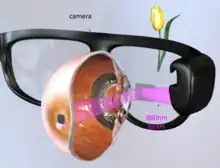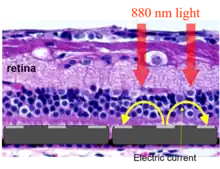

Photovoltaic retinal prosthesis is a technology for restoring sight to patients blinded by degenerative retinal diseases, such as retinitis pigmentosa and age-related macular degeneration (AMD), when patients lose the 'image capturing' photoreceptors, but neurons in the 'image-processing' inner retinal layers are relatively well-preserved.[1] This subretinal prosthesis is designed to restore a patients' sight by electrically stimulating the surviving inner retinal neurons, primarily the bipolar cells. Photovoltaic retinal implants are completely wireless and powered by near-infrared illumination (880nm) projected from the augmented-reality glasses. Therefore, they do not require such complex surgical methods as needed for other retinal implants, which are powered via extraocular electronics connected to the retinal array by a trans-scleral cable.[2] Optical activation of the photovoltaic pixels allows scaling the implants to thousands of electrodes.
Studies in rats with retinal degeneration demonstrated that prosthetic vision with such subretinal implants preserves many features of natural vision, including flicker fusion at high frequencies (>20 Hz), adaptation to static images, antagonistic center-surround organization and non-linear summation of subunits in receptive fields, providing high spatial resolution.[3] Grating visual acuity measured with 70μm pixels matches the sampling density limit (pixel pitch).[4]
Clinical trial with these implants (PRIMA, Pixium Vision) having 100μm pixels demonstrated that AMD patients perceive letters and other patterns with spatial resolution closely matching the pixel size.[5] Moreover, central prosthetic vision is perceived simultaneously with the remaining natural peripheral vision.
Implants of a new design with pixel sizes down to 20μm[6] are being developed by Palanker group at Stanford University.
References
- ↑ Wang, Lele; et al. (2012). "Photovoltaic retinal prosthesis: Implant fabrication and performance". Journal of Neural Engineering. 9 (4): 046014. Bibcode:2012JNEng...9d6014W. doi:10.1088/1741-2560/9/4/046014. PMC 3419261. PMID 22791690.
- ↑ Mathieson, Keith; et al. (2012). "Photovoltaic retinal prosthesis with high pixel density". Nature Photonics. 6 (6): 391–397. Bibcode:2012NaPho...6..391M. doi:10.1038/nphoton.2012.104. PMC 3462820. PMID 23049619.
- ↑ E. Ho; et al. (2018). "Spatio-temporal Characteristics of Retinal Response to Network-mediated Photovoltaic Stimulation". Journal of Neurophysiology. 119 (2): 389–400. doi:10.1152/jn.00872.2016. PMC 5867391. PMID 29046428.
- ↑ H. Lorach; et al. (2015). "Photovoltaic Restoration of Sight with High Visual Acuity". Nature Medicine. 21 (5): 476–482. doi:10.1038/nm.3851. PMC 4601644. PMID 25915832.
- ↑ D. Palanker; et al. (2022). "Simultaneous Perception of Prosthetic and Natural Vision in AMD Patients". Nature Communications. 13 (1): 51321. Bibcode:2022NatCo..13..513P. doi:10.1038/s41467-022-28125-x. PMC 8792035. PMID 35082313.
- ↑ B.Y Wang; et al. (2022). "Electronic Photoreceptors Enable Prosthetic Vision with Acuity Matching the Natural Resolution in Rats". Nature Communications. 13 (1): 6627. doi:10.1038/s41467-022-34353-y. PMC 9636145. PMID 36333326.
External links